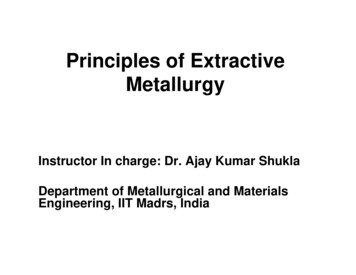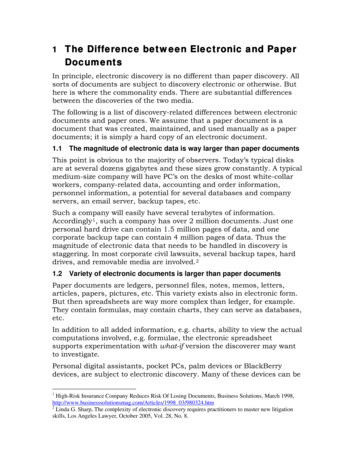
Transcription
The Differences Between Extractiveand In-Situ Emissions MonitoringNOVA Analaytical Systems1.800.295.3771www.nova-gas.com
Emissions monitoring has become increasingly importantfor industrial facilities in recent past. Since the 1970’s,the US Environmental Protection Agency (EPA) hasbeen empowered to establish rules and regulations onair pollution in the USA, outlining guidelines for someindustrial processes and ultimately imposing limits toemissions. Many other countries have modeled theirgovernment environmental programs after the US EPA.In 1990, the US Clean Air Act also mandated enhancedprograms of periodic monitoring of many pollutantsfrom stationary sources. Effective emissions monitoringensures that companies remain in compliance withregulatory or permit limits (under emissions tradingprograms), and contributes to a robust nationalemissions inventory data.Emissions monitoring can also give companies animportant insight into the operational efficiency oftheir industrial combustion processes. This may leadto reductions in fuel use and improvements toequipment maintenance and durability.There are two main types of emissions monitoringsystems: in-situ and extractive. In-situ measures thesample at the point source, whereas extractive extractsa sample for measurement away from the point source.We will discuss each in more detail hereafter.It should be noted that the different styles of monitoringsystems can also be applied to process applicationsother than flue gas and emissions applications.
In-Situ MonitoringWith in-situ monitoring, the gas sensor / detector is placed directly at or insidethe duct or stack. A portion of the measurement device is immersed in the samplegas – hence the term “in-situ”. These analyzers may feature optical or electrochemicaltypes of sensors. These systems always have some type of signal output thatcorresponds to the gas reading.There are two types of in-situ measurements: point (in-stack) and path (cross-stack).NOVA Analaytical Systems1.800.295.3771www.nova-gas.com
In-Situ Monitoring continuedPoint (in-stack) measurements are performed at the exact location of the samplingcell. The gas sensor is located in the probe that is immersed in the flowing sample gas.Electrochemical or zirconia sensors are commonly used in point style systems.Path (cross-stack) measurements are taken across a path in the emissions stream.In most cases, path measurements are made by sending an optical signal such as alaser across the duct or stack and reflecting that signal back to a detector. Alternately,the detector may be located directly across from the signal generator without theneed for a reflector. The instrument is set up so that specific pollutants selectivelyabsorb some of the optical signal and are interpreted as concentrations of the overallgas sample.Applications In-situ analyzers are often used in the steel, paper, metal heat treating,and power industries. For example, an in-situ oxygen analyzer can be used to analyzeflue gas streams from boilers. In-situ analyzers are also frequently used to measurecarbon monoxide in heat treat furnaces or dew point in atmosphere gas generator lines.Advantages of In-Situ Gas Analyzers The response time of in-situ systems is usuallyquite fast because the sensor is very close to the process. No sample gas is extractedfrom the stack in in-situ systems, which can simplify installation. Equipment cost is oftenless when only one or two gases need to be measured.Disadvantages The sensors are directly exposed to untreated and potentially corrosiveprocess gas in many cases. The system components may also be exposed to vibration& high temperatures. The measurement point may be within a classified hazardous areawhich may require special design considerations. Analytical interferences may reducethe accuracy of the measurement. In-situ systems that measure multiple gases withinthe sample gas are frequently quite expensive. Maintenance, when needed, can alsobe complicated by the fact that the equipment is mounted immediately adjacent to theprocess.NOVA Analaytical Systems1.800.295.3771www.nova-gas.com
Extractive MonitoringExtractive–style systems take a continuous gas sample from the process stream,remove impurities and water from it, and pump it to an analyzer which may be locatedsome distance away from the extraction point.This setup is especially convenient as it protects the device from the harmful exposureto the plant environment (high temperatures and pressures, corrosion, and damagecaused by exposure to particulate matter) and can monitor the target gas with highaccuracy, thanks to the dedicated and sheltered location of the measurement. Extractivesystems may vary in design based on the type of sample conditioning that is required.Some systems maintain the sample gas temperature to prevent condensation of watervapor, while others allow the sample to cool and condensation to form.The analyzer will usually have a local display of the gas reading. It can also send anelectrical or digital signal to the customer’s receiving device (DCS, PLC, etc.). Variousdiagnostic and alarming functions may also be available. Infrared, electrochemical,thermalconductivity, paramagnetic and other types of detectors can be used inextractive analyzers.Applications Extractive systems are regularly used in all different types of combustionapplications where the exhaust gas must be measured. Applications that produceprocess gas as an output, such as landfills, biogas reactors, and gasifiers, are well-suitedfor extractive analyzer systems, especially for dusty or corrosive applications.NOVA Analaytical Systems1.800.295.3771www.nova-gas.com
Advantages of Extractive Systems Extractive style analyzers can be located awayfrom the process in an easier-to-reach, climate-controlled location. More convenientlocation generally means easier maintenance and calibration. There is a wide choiceof cabinet styles and configurations available. Extractive analyzers are readily availablein multi-gas configurations that are less expensive than the in-situ equivalents.More stringent sample preparation and the ability to compensate for gas crossinterferences contribute to high accuracy and more choice of analysis ranges.Disadvantages Extractive systems require the extraction of sample gas from theprocess, which may be undesirable in some cases. Sample tubing must be installedbetween the extraction point and the analyzer. Transporting the sample out ofthe process takes time which may result in a slower response time in the analyzer.Extractive systems frequently have a larger foot-print than some in-situ systems.Extractive systems that are only used for measurement of one gas in the samplemay be more expensive than the in-situ equivalents.Selecting an Analyzer SystemIn-situ and extractive analyzer systems each offer salient benefits and both continueto benefit from ongoing technology advances. The best type of analyzer in a givensituation may depend on several factors including measurement ranges required,gas temperature and pressure, gas quality, and ambient conditions. The operatormay have past expertise and a level of confidence with one type of system overanother. Price, required accuracy, and required service duration may also beinfluencing factors.Nova SolutionsNova Analytical Systems specializes in the design and manufacture of extractive gasanalyzer systems.Our design philosophy includes the following goals for our gas analyzer products: Easy & intuitive to use and operate Accurate and reliable gas measurement data Easy to install Easy diagnostic and service, modular design with access to main componentsand voltage points Durable enclosures and sampling components Various sample conditioning options to match different applications Local displays and optional data outputs via analog/digital channelsNOVA Analaytical Systems1.800.295.3771www.nova-gas.com
ConclusionThe right type of emissions monitoring system depends on a number of factorsincluding the site conditions, data requirements, and a cost-benefit analysis.To learn more about extractive gas analysis, visit our website. You can alsocontact us if you have any questions about selecting the right gas analysissystem. Our experts are always happy to helpNOVA Analaytical Systems1.800.295.3771www.nova-gas.com
regulatory or permit limits (under emissions trading programs), and contributes to a robust national emissions inventory data. Emissions monitoring can also give companies an important insight into the operational efficiency of their industrial combustion processes. This may lead to reductions in fuel use and improvements to










